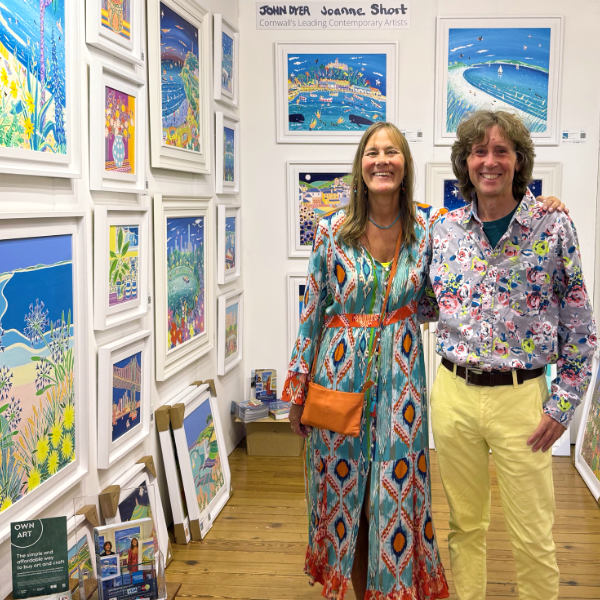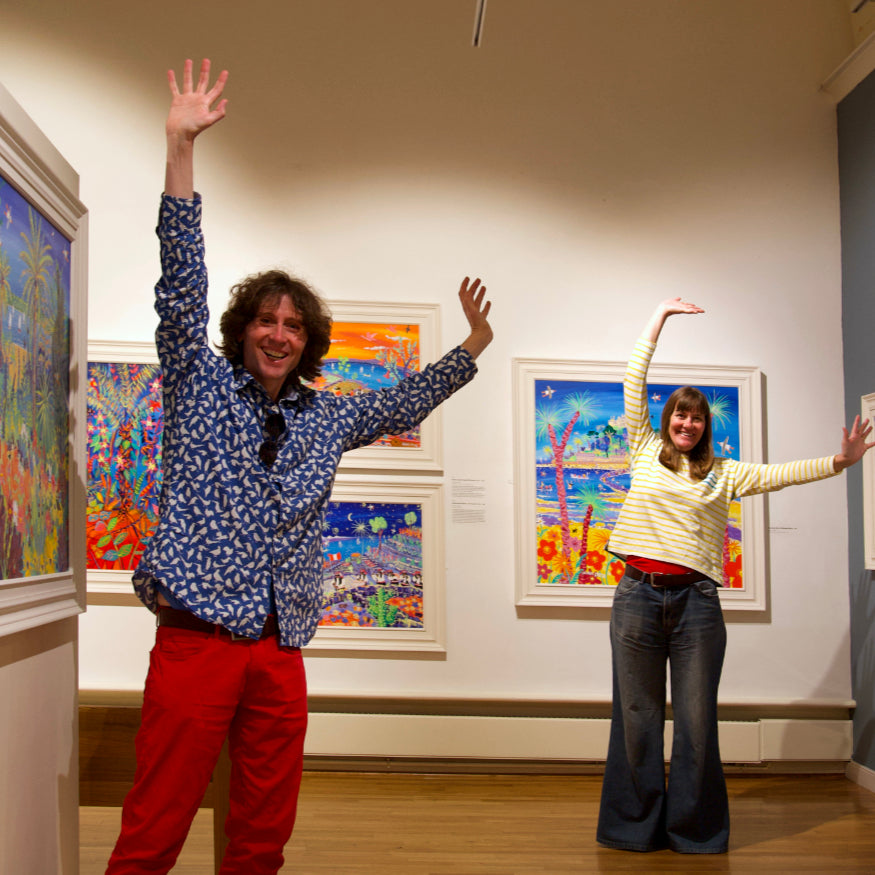Invest in British Art from Cornwall's Leading Artists | Free Worldwide Delivery
JOHN DYER
Original Paintings
New paintings available to buy online now by Cornwall's best loved artist.
JOANNE SHORT
Original Oil Paintings
New paintings available to buy online now by Cornwall's acclaimed colourist painter.
TED DYER
Original Oil Paintings
New paintings available to buy online by Cornwall's best known impressionist artist.
All Original Paintings
View all of the new original paintings that we have available to buy online now in our online gallery.
The ones you missed
View all of the recently sold original paintings by our Cornish artists John Dyer, Ted Dyer and Joanne Short.
Cornwall Art Prints
Museum-quality prints. Framed, Unframed, Signed & Wall Art Posters
September 5th - 7th 2025
Untitled Art Fair Chelsea, London
We will be exhibiting at the prestigious Untitled Art Fair, in Chelsea Old Town Hall.
June 6th - 8th 2025
St Ives Summer Exhibition 2025
New paintings by John Dyer & Joanne Short in the historic Porthmeor Studios in St Ives.
Christmas Exhibition 2024
A beautiful collection of new paintings by John Dyer & Joanne Short in the historic Porthmeor Studios in St Ives.
Explore our Previous Exhibitions
Enjoy exploring our previous exhibitions online and discover extraordinary paintings you can own today.
Press Coverage and Testimonials
Art Collectors Club.
Enjoy 5% off your first order, regular offers, exclusive exhibition invitations and artist and gallery updates in our monthly email newsletter.
"I am familiar with many of the beautiful places that John and Joanne have painted in their native Cornwall; where their work is well known. I admire them for branching out into new pastures. Their style is well suited to the Riviera and I think they have captured the lushness and exuberance of the flora around Menton very well. We are blessed with wonderful light on the Mediterranean which they have used to great effect, their pictures are guaranteed to lift ones spirits and make one smile."
Carolyn Hanbury - Giardini Hanbury

The year 2007 brought about a big change in the lives of John and his family. They had always enjoyed visiting the gardens of the Côte d’Azur during regular visits to the south of France, and noticed the many similarities between them and the coastal gardens John had been painting in Cornwall, both in the range and type of plants and in the way they are planted, on steep descending cliff faces framed with stunning sea views. From his work on Tresco and in the Fox family gardens on the Helford, John was also aware of strong historical and sometimes family links between French and Cornish garden owners.
Two of the most beautiful gardens on the Côte d’Azur, the Clos du Peyronnet in Menton and the Giardini Hanbury a few miles east near Ventimiglia in Italy, were owned and planted by Englishmen, though a slightly earlier botanical garden, the Jardin Thuret on the Cap d’Antibes, which became the inspiration for much of the planting along that part of the French coast, was created by the French botanist Gustave Thuret (1817–1875).
The most renowned garden on the Côte d’Azur is the Giardini Hanbury (its official name, La Mortola, is taken from the local village). Forty years after the garden was first purchased, in 1867, by Thomas Hanbury, a Quaker businessman (another link to the great garden creators of Cornwall), it was described by the novelist Arnold Bennett as ‘the finest private garden in the world, 100 acres, 5,000 species (some absolutely unique) and 46 gardeners’. Thomas and his brother Daniel planted the terraces with aloes and agaves, eucalyptus trees from Australia, drought-loving plants from South Africa, Chinese wisteria and native Italian cypresses, and in the first year alone no fewer than 47 types of exotic mimosa. By the turn of the century, the garden was supplying seed packets by the thousand to the botanical gardens of the world. Thomas Hanbury entered the ranks of great garden benefactors through his purchase in 1902 of the site of Wisley which he gave the following year to the RHS (still its main garden).
A descendant by marriage of the original family still lives at the Giardini Hanbury, although ownership of the gardens was transferred to the University of Genoa in the 1980s. It was Carolyn Hanbury’s generous offer of the free use of a studio in the school building at the gardens which prompted John’s decision to relocate his family there. John, Joanne and the girls found accommodation in Menton, where they had recently spent a happy holiday, and in their official capacity as Artists in Residence travelled the few miles over the border into Italy each day to paint in the gardens, as well as going further afield to seek out and paint the other beauties of the Côte d’Azur.
In Martha-Lilly’s words, ‘Moving to Menton was a huge thing for the whole family. Embracing a whole new culture was challenging at times but we eventually got used to the French joie de vivre. When we first moved, all we did was art. I remember going most days with my dad to the studio in the Hanbury Gardens, and running round the beautiful botanical gardens, or the old town of Mortola, just enjoying an artistic lifestyle.’
"The room transported me back to an experience I had when I played Dora Marr, one of Picasso’s mistresses [in the play Picasso’s Women at the Edinburgh Festival in 2000], which was to see how rich and rewarding the Riviera is to the painter. To be in John’s studio and to see how the light, the beauty of the Riviera and the wealth of culture surrounding him had inspired him, allowed me to experience why artists are drawn to this area in particular. His brave use of colour and broad truthful brushstrokes make a direct hit on the retina."
Toyah Willcox
One visitor to the studio at La Mortola was the actress and singer Toyah Willcox, who owns a small apartment in Menton, as like many artists and musicians she prefers its quieter pace of life to the glitzy attractions of nearby Monaco. Toyah commented that ‘the room transported me back to an experience I had when I played Dora Marr, one of Picasso’s mistresses [in the play Picasso’s Women at the Edinburgh Festival in 2000], which was to see how rich and rewarding the Riviera is to the painter. To be in John’s studio and to see how the light, the beauty of the Riviera and the wealth of culture surrounding him had inspired him, allowed me to experience why artists are drawn to this area in particular. His brave use of colour and broad truthful brushstrokes make a direct hit on the retina.’ Later she borrowed several of John’s paintings for a photo-shoot in her apartment, and said that she would gladly have purchased the whole collection if they had been available.
While John focused on the undeniable beauty of the Giardini Hanbury and revelled in its spectacular setting, it was impossible to avoid comparisons with better-preserved gardens in Cornwall, particularly those like Heligan and Trebah which have been recently restored. The point was forcibly made by Robin Lane Fox, the eminent historian and gardening correspondent of the Financial Times, in an article (17 May 2017) written to mark the 150th anniversary of Thomas Hanbury’s purchase of La Mortola. Fox bemoaned the decline of this once-great garden, compounded by lack of interest from the Italian authorities, the absence of a comprehensive replanting strategy and the low visitor numbers – 40,000 a year, compared to the hundreds of thousands who flock into Heligan and Eden. Supporting this view, John suggests that the Giardini Hanbury could be ripe for ‘a Heligan-style re-discovery. It is a garden that’s dying, not growing; it is crying out for the attention of an entrepreneur with vision, an Italian Tim Smit to kick it into life.’
The original plan was for the family to stay in France for a year, but the wealth of material to paint in the area caused them to reconsider; moreover Martha-Lilly had enrolled at the Conservatoire in Menton and the musical education she was receiving was so beneficial that one year soon turned into three. Meanwhile John somehow managed to juggle numerous other artistic commitments simultaneously – travelling to and from Cornwall regularly to fulfil the roles of Official Artist for the 2008 Tall Ships Regatta in Falmouth and Artist in Residence for the South West ‘Darwin 200’ celebrations at Newquay Zoo and Falmouth Art Gallery, and
also fitting in a trip to Peru to record the potato harvest for the International Potato Center!

At the end of their first year in the south of France, John and Joanne held an exhibition of their Côte d’Azur paintings at the Hôtel Hermitage in Monaco. The catalogue contained contributions from Carolyn Hanbury, who complimented the way they had ‘captured the lushness and exuberance of the flora around Menton’; from Brian Stewart for Falmouth Art Gallery; and a fulsome tribute from Hugues de la Touche, Curator of Menton Museums, who declared that ‘John Dyer possède un regard d’une innocence complète. Il magnifie la beauté de la nature…Son univers est lisse, étonnement serein, d’une tranquillité absolue.’ John has always maintained that for him, his paintings are about ‘family, fun, colour and taking an optimistic view of the world’ and it is hard to imagine a more complete reflection of his attitude to life than in this ravishing collection. From the scorching heat of the beaches of Nice and Cannes to the quieter views of children playing in the garden under citrus trees with a backdrop of deep azure sea, the paintings present an idyllic view of the Riviera, perhaps nowhere more so than in his ever-popular nocturnal scenes – one can almost smell the warm, scented night air and hear the cicadas.
Explore our main art collections to find perfect original paintings, limited edition signed prints, open-edition prints, wall art prints and posters & artist designed gifts.
N.B. If you don’t see your confirmation email shortly, please check your spam or junk folder.
A stunning picture that was efficiently delivered to Amsterdam in a very short time frame.
From order to delivery the process was fast and efficient, especially as it was to the Netherlands.
Loved this case for my new iPhone 16 pro - it makes me smile and the vibrant colours are just gorgeous
Love it. So cheering on these dark days of winter. Thank you John.
I was looking for a print of st ives and came across John dyers work . I particularly like the colours and style of this piece , especially the fat seagulls . It’s complete fun in a frame and reminds us of happy days spent at the harbour
The print is fabulous, beautiful and my sister will love it. Thank you
Really like this picture as it brings brightness to our kitchen diner. We framed it with a white border and blue second border. Looks amazing
We love John’s pictures of France. We already have an original of Nice but bought this poster as it brings back so many wonderful memories.
Superb communication and attentiveness from gallery. The poster is of course wonderful.
Love this print - bright, sunny and makes one feel warm and happy!
Delivery was all easy and straightforward. Many thanks.
The print is even better in real life. It’s printed on beautiful quality paper which makes the colours really pop and the painting itself is simply charming. It brings so much joy to us. We love it! Thank you
A lovely art print bought as a memory of our holidays on the beautiful Isles of Scilly.
The frame is very well made and displays the art print beautifully. Ordering from John Dyer Gallery was simple and delivery swift. I would not hesitate to order from them again.
Thank you so much for the amazing customer service, and most beautiful painting of our favourite place
Absolutely beautiful painting. So thrilled with it. Completely amazing service: beautifully packaged, framed and safely delivered really quickly.
Lovely picture, bought 3 after our recent trip to Cornwall. Already thinking of getting more.
Have walked this coastal path from St Agnes to Chapel Porth and back countless time. I am now pleased that this fabulous print is the first thing I see every morning. Beautiful, happy colours. Nice frame. I’m now planning of ordering one of Mount’s Bay by same artist.




